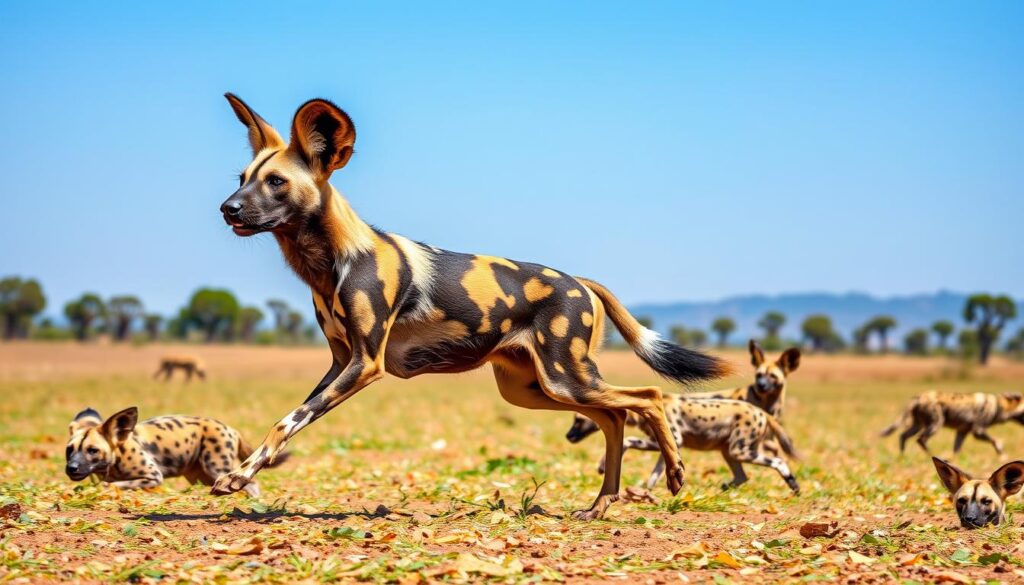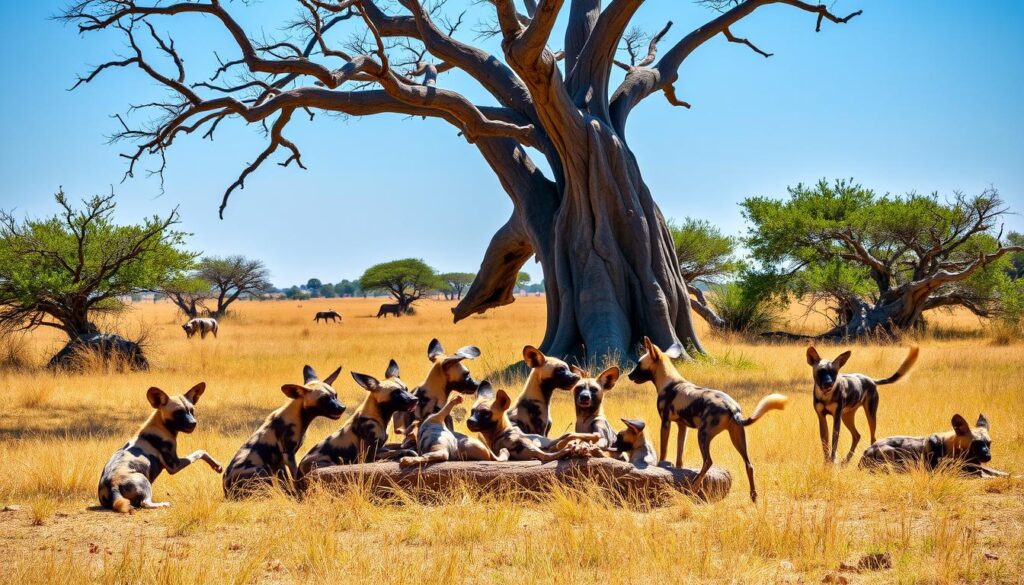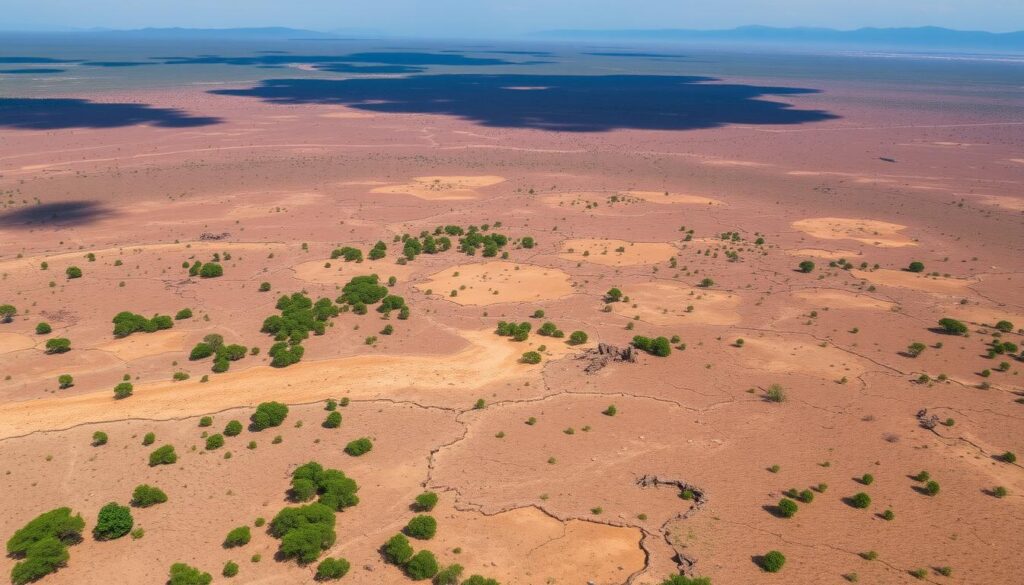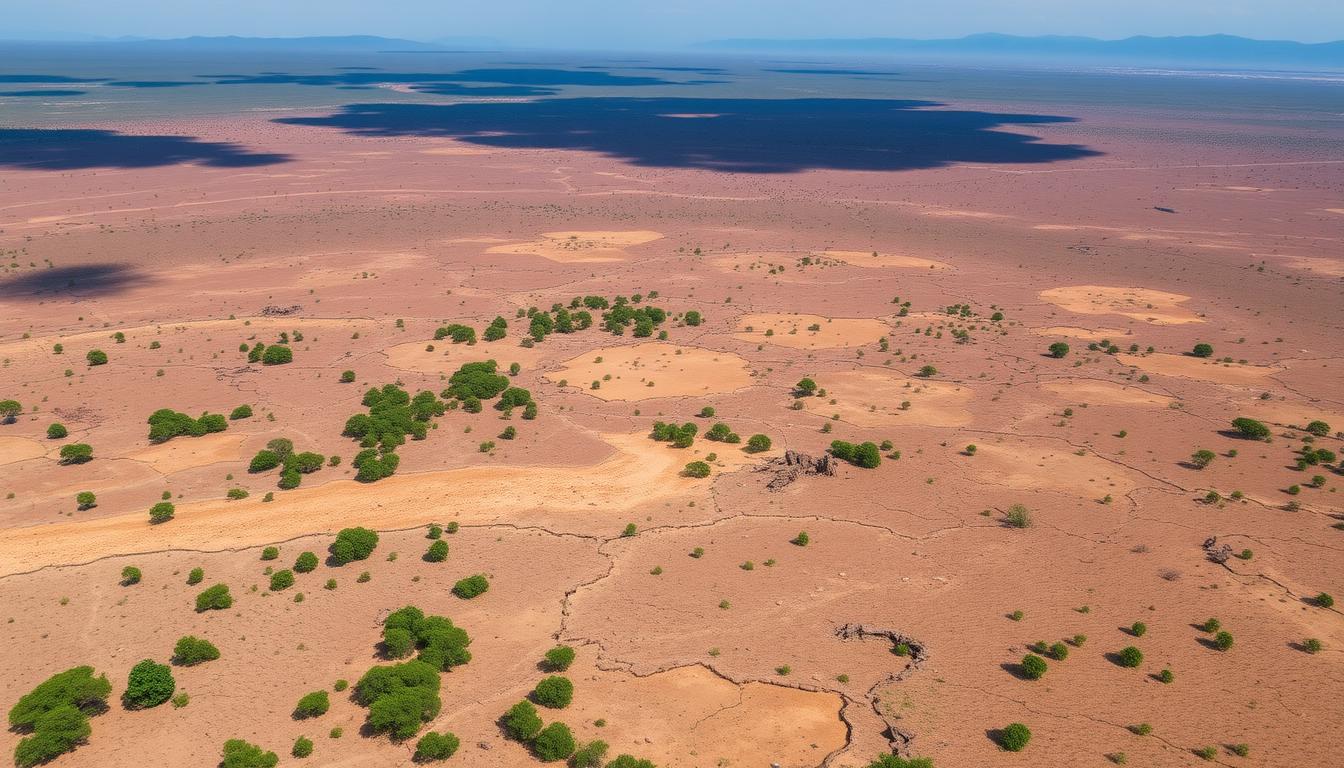The African wild dog roams the wild savannas and woodlands of Africa. Known as the “painted wolf” or “Cape hunting dog,” it’s a unique and skilled hunter. It has won the hearts of many who love nature and wildlife.
Its scientific name, Lycaon pictus, makes it a symbol of the African wild. Its mottled fur, big ears, and strong jaws make it stand out. It shows how diverse and adaptable dogs can be.

But, the African wild dog’s status as a top predator is at risk. It faces many dangers like losing its home, conflicts with humans, and diseases. Efforts to save it are ongoing, but the path ahead is tough.
Key Takeaways
- The African wild dog, also known as the “painted wolf” or “Cape hunting dog,” is the world’s most successful pack hunter.
- With its unique and striking appearance, the African wild dog is a true icon of the African wilderness.
- The African wild dog faces numerous threats, including habitat loss, human-wildlife conflict, and disease, making it an endangered species.
- Conservation efforts are underway to protect the future of this remarkable animal, but the challenges are significant.
- Lycaon pictus, the scientific name for the African wild dog, is a captivating and highly specialized canine species.
Introduction to the African Wild Dog: Nature’s Pack Hunter
The African wild dog, also known as the painted dog, is a remarkable predator. It has played a significant role in the delicate balance of African ecosystems. These canines are known for their efficient and cooperative hunting strategies. They help maintain ecosystem balance.
Historical Significance in African Ecosystems
For centuries, the African wild dog has been a key part of the African predator community. They shape the dynamics of prey populations and influence ecosystem health. Their unique hunting methods, involving coordinated pack movements, have allowed them to thrive. This contributes to the natural regulation of herbivore numbers.
Current Conservation Status
Unfortunately, the African wild dog is now considered an endangered species. They face many threats, including habitat loss, human-wildlife conflict, and disease outbreaks. Conservation efforts are underway to protect these remarkable animals. They aim to ensure their continued existence in the wild.
“The African wild dog is a true marvel of nature, a living embodiment of the delicate balance that sustains the African wilderness.”
Physical Characteristics of Africa’s Wildest Dog
The African wild dog, also known as the painted dog, is a unique and captivating canine. It has a distinctive spotted coat, large rounded ears, and a lean muscular build. This makes it a sight to behold in the African wilderness.
One of the most striking features of the African wild dog is its spotted coat. The mottled pattern of black, white, and tan patches helps it blend into its surroundings. It also aids in identifying individual pack members.
African wild dogs have large, rounded ears and a lean, athletic body. This body type allows for incredible speed and agility. Their powerful jaws and formidable bite force make them formidable hunters, capable of taking down prey much larger than themselves.
| Physical Trait | Description |
|---|---|
| Coat | Mottled pattern of black, white, and tan patches |
| Ears | Large, rounded, and distinctive |
| Body | Lean, muscular, and agile |
| Bite Force | Powerful jaws with a formidable bite |
“The African wild dog is a marvel of evolution, with a unique appearance and unparalleled hunting abilities.”
Habitat and Geographic Distribution
The African wild dog, also known as the painted dog, calls the savanna, grasslands, and woodlands of sub-Saharan Africa home. These dogs live in many different places, from the green savannas of east and southern Africa to the tough grasslands and woodlands of central and western areas.
Preferred Territories
African wild dogs like open spaces with lots of plants. They hunt best in areas with a mix of savanna, grasslands, and woodland. This mix gives them plenty of food and places to hide.
Range Reduction Over Time
Long ago, African wild dogs roamed a huge part of Africa. But now, their numbers are much lower because of habitat loss and fragmentation. They have lost many of their old homes and their range has shrunk a lot in the last 100 years.
Current Population Centers
- Southern Africa, especially in Botswana, Zimbabwe, and South Africa
- East Africa, with strongholds in Tanzania and Kenya
- Parts of central Africa, such as Zambia and the Democratic Republic of the Congo
Even though their range has shrunk, African wild dogs still do well in some protected places and national parks. But, habitat loss and fragmentation are still big dangers to their survival.
| Habitat Preference | Historical Range | Current Population Centers |
|---|---|---|
| Savanna, grasslands, woodland | Widespread across sub-Saharan Africa | Southern, East, and Central Africa |
Social Structure and Pack Dynamics
The African wild dog is a highly social species. They live and hunt in tightly bonded packs. At the heart of their social structure is the alpha pair – the dominant male and female who lead the pack. These alpha individuals establish a strict pack hierarchy, with each member playing a specific role within the group.
Cooperative breeding is a hallmark of African wild dog packs. The alpha pair takes on most of the breeding and pup-rearing duties. Lower-ranking pack members, known as subordinates, help care for the young. This shows the strong social bonds that unite the pack.
- The alpha pair maintains order and makes critical decisions for the pack
- Subordinate members contribute to the pack’s success through cooperative hunting and pup care
- Tight-knit social relationships and a clear hierarchy help the pack function effectively
This intricate social structure and the deep social bonds shared by pack members are crucial for the African wild dog’s survival. The pack’s cohesion and teamwork allow them to thrive as cooperative breeders and efficient pack hunters.
| Social Characteristic | Description |
|---|---|
| Alpha Pair | The dominant male and female who lead the pack |
| Pack Hierarchy | A strict social structure with defined roles for each member |
| Cooperative Breeding | The alpha pair breeds while subordinates assist in pup care |
| Social Bonds | The strong relationships that unite the pack and ensure its cohesion |

Hunting Behavior and Techniques
The African wild dog is known for its amazing hunting skills. It uses special techniques to catch even the biggest prey. These dogs are experts at endurance hunting, using their stamina to chase down their prey.
Pack Hunting Strategies
African wild dogs hunt together, making them very coordinated. They use tactics like encirclement and ambushes to catch their large prey. This teamwork makes them very efficient hunters.
Prey Selection
- African wild dogs mainly hunt medium to large-sized animals like impalas and wildebeests.
- They pick the weakest members of a herd, like young or injured ones, to hunt.
- Thanks to their teamwork, they can take down prey much bigger than themselves.
Success Rates in the Wild
The African wild dog’s hunting success is impressive, with a rate of up to 80%. This shows their hunting efficiency is unmatched. Their teamwork, stamina, and adaptability make them top predators in the wild.
Breeding and Life Cycle
The African wild dog, also known as the painted dog, is famous for its unique breeding and care rituals. These social canines have a fascinating life cycle. It is closely tied to their dynamic pack structure.
During the breeding seasons, which usually happen during the rainy months, the pack’s alpha pair mates. The female picks a secluded denning site, like an old aardvark or termite mound. There, she gives birth to a litter of pups. The whole pack helps with pup rearing, ensuring the young ones are safe and well cared for.
The cooperative care shown by African wild dogs is amazing. Both males and females help with feeding and guarding the pups. This teamwork is key to the pups’ survival and learning important hunting and survival skills.
| Breeding Cycle Stages | Duration |
|---|---|
| Mating | 1-2 weeks |
| Gestation | 69-73 days |
| Pup Rearing | 10-12 weeks |
| Weaning | 3-4 months |
The African wild dog’s breeding and life cycle show their adaptability and complex social dynamics. Understanding these behaviors helps us see the important role they play in African ecosystems.
Communication Methods Within the Pack
African wild dogs have amazing pack dynamics. They use many ways to stay together and work well as a team. Their sounds, body language, and scent marking help them survive and hunt together.
Vocal Communications
Their voices are key for working together. They make different sounds like whines, barks, and growls. These help them talk to each other.
They have special “rallying calls” to get everyone ready for hunting. Or to find each other after a chase.
Body Language and Visual Signals
They also use body language and signals. Their posture shows if they’re ready to hunt or if they’re feeling calm. Scent marking helps them know who’s who and where they are.
These dogs’ ways of talking to each other help them be top predators in Africa. Learning about their communication helps us understand their social lives and how they adapt to their world.
Threats to Survival in Modern Africa
The African wild dog is incredibly resilient and adaptable. Yet, it faces many threats in today’s Africa. Habitat loss, human-wildlife conflict, diseases, and poaching have all hurt their numbers.
Habitat loss is a big problem. Human activities like building homes and farms take over their space. This makes it hard for wild dogs to hunt and find safe places to live.
Humans also see wild dogs as threats to their livestock. This leads to killings by farmers and herders. These actions harm the wild dog populations.
- Diseases like canine distemper and rabies can wipe out entire packs. This leaves them open to more decline.
- Poaching, for the illegal trade and traditional medicine, also hurts their survival.
These threats have greatly reduced the African wild dog’s range and numbers over the last century. We need to work together to save this amazing species.
| Threat | Impact on African Wild Dogs | Mitigation Strategies |
|---|---|---|
| Habitat Loss | Disrupts hunting and denning behaviors, leading to population declines | Establishing protected areas, corridor restoration, and sustainable land-use practices |
| Human-Wildlife Conflict | Retaliatory killings by farmers and herders seeking to protect livestock | Implementing livestock protection measures, community-based conservation initiatives, and education programs |
| Disease | Outbreaks of diseases like canine distemper and rabies can devastate entire packs | Vaccination programs, disease monitoring, and improving veterinary care for wild populations |
| Poaching | Targeted killings for the illegal wildlife trade and traditional medicine | Strengthening anti-poaching patrols, enforcing wildlife protection laws, and reducing demand for wild-caught animals |

“The survival of the African wild dog is a true test of our commitment to protecting the delicate balance of nature in modern Africa.”
Conservation Efforts and Success Stories
The African wild dog faces many threats, but conservation efforts are underway. These efforts aim to protect the remaining wild dogs and help them recover.
Major Conservation Programs
International organizations have launched big conservation programs for the African wild dog. They use various strategies, including:
- Creating wildlife corridors to connect habitats and let wild dogs roam freely
- Putting in place anti-poaching measures to stop illegal hunting and trade
- Starting education programs to teach people about the importance of wild dog conservation
- Monitoring wild dog populations to make informed decisions and track their recovery
Community-Based Protection Initiatives
Local communities are also crucial in protecting the African wild dog. They work on:
- Working with farmers and livestock owners to reduce conflicts and killings
- Helping design and implement conservation strategies that meet local needs
- Empowering community members to care for their local wild dog populations and habitats
These efforts have shown promise, with some wild dog populations starting to recover. By combining science, community involvement, and a strong commitment, conservationists are working hard to save the African wild dog.
Conclusion
The African wild dog is a remarkable species that plays a vital role in African ecosystems. They have unique hunting techniques and social structures. Their adaptations have captured the fascination of people worldwide.
However, threats like habitat loss and human-wildlife conflict endanger them. This has put the endangered species in a precarious position.
Conservation efforts offer hope for the African wild dog’s future. Organizations, researchers, and local communities work together. They do anti-poaching patrols, habitat restoration, and community protection.
It’s crucial to keep protecting the African wild dog. This ensures they remain part of Africa’s natural heritage for future generations.
Protecting the African wild dog also safeguards the continent’s biodiversity. Our efforts help these creatures roam Africa’s savannas and grasslands. They inspire awe and wonder in all who see them.
The survival of the African wild dog shows nature’s resilience. It highlights our role as stewards of the natural world.
FAQ
What makes the African wild dog Earth’s wildest dog species?
The African wild dog, also known as the painted wolf or Cape hunting dog, is Earth’s wildest dog. It has a unique coat, large ears, and a lean build. Its pack hunting is also very efficient and coordinated.
What is the current conservation status of the African wild dog?
The African wild dog is listed as endangered by the International Union for Conservation of Nature (IUCN). Their numbers have dropped due to habitat loss, human conflict, and diseases. Efforts are being made to save this amazing predator and increase its numbers.
How do African wild dogs communicate within their packs?
African wild dogs use many ways to talk to each other. They bark, whine, and use body language and scent. These methods help them hunt together successfully.
What are the major threats to the survival of African wild dogs?
African wild dogs face many dangers. These include losing their homes, conflicts with humans, diseases, and being hunted. As their habitats shrink, they struggle to survive.
What are some of the successful conservation efforts for the African wild dog?
Groups and local communities are working to save the African wild dog. They create wildlife paths, fight poaching, and teach people about these dogs. These actions have helped some populations grow, showing they can thrive with help.
